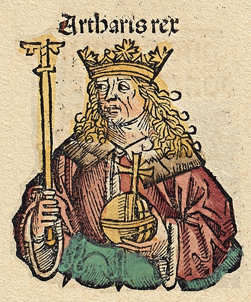Authari facts for kids
Quick facts for kids Authari |
|
|---|---|
| King of the Lombards | |

Woodcut vignette of Authari in the 1493 Nuremberg Chronicle
|
|
| Reign | 584 – 590 |
| Predecessor | Rule of the Dukes |
| Successor | Agilulf |
| Born | c. 550 |
| Died | 5 September 590 Pavia, Neustria Lombard Kingdom |
| Spouse | Theodelinda |
| Father | Cleph |
| Religion | Arianism |
Authari (born around 550, died September 5, 590) was a powerful king of the Lombards. He ruled from 584 until his death. Authari is remembered as the first Lombard king who started to adopt some Roman ways. He also brought in new rules that changed how Romans were treated. Plus, he allowed more freedom for the Christian faith.
Authari's Rule
Authari was the son of Cleph, who was also a King of the Lombards. After his father was killed in 574, the Lombard nobles didn't choose a new king right away. This led to a ten-year period called the Rule of the Dukes. During this time, powerful local leaders were in charge.
In 574 and 575, the Lombards tried to invade a region called Provence. This area was part of the kingdom of Burgundy, ruled by King Guntram. However, the Burgundians fought back hard. They pushed the Lombards back across the Alps into northern Italy.
Around this time, the Burgundians teamed up with the Byzantines. The Byzantines were part of the Eastern Roman Empire. Their combined armies marched into Italy. They reached areas like Meran and almost got to Trent. But the Lombard Duke of Trent, Euin, fought them off. He even won a big victory near Salurn. Duke Euin also made the Lombards stronger by marrying the daughter of Garibald I, the duke of Bavaria. This marriage helped create important alliances.
Becoming King
In 584, the Franks, who were working for the Byzantines, invaded Italy again. Because of this pressure, the Lombards decided they needed a strong leader. They chose Duke Authari to be their king. Authari quickly defeated the invaders.
Another Frankish attack happened in 588. This time, it was a disaster for the Franks. King Authari's Lombards and Duke Garibald's Bavarian forces were allies. Together, they defeated the invading armies.
The Byzantines also tried to get one group of barbarians to fight another. They convinced a mercenary leader named Droctulf to leave the Lombards. Droctulf then joined the Byzantine forces. But Authari still managed to defeat Droctulf's army. Droctulf had to retreat to Brescia and Ravenna.
In 590, another big army of Franks and Byzantines attacked the Lombards. They wanted to drive the Lombards out of Italy completely. They captured a few cities like Modena and Mantua. But they had to stop when they reached the Lombard capital, Pavia. They learned that a Frankish leader had signed a truce with King Authari. This forced them to go back home. These events showed that the Lombards were here to stay in Italy.
Religion and Marriage
Authari became a follower of Arianism, which was a different form of Christianity. He allowed more religious freedom than earlier Lombard kings. However, he did not want Lombard children to be baptized as Catholics. He thought Catholicism was a tool of the Byzantine Empire. He believed it would make his warriors less strong.
King Authari married Theodelinda on May 15, 589, in Verona. She was the daughter of the Bavarian duke Garibald I. This marriage was very important for political reasons. It helped make Authari's position as king even stronger. Theodelinda was chosen because the Lombards and Bavarians had long-standing ties. They also both disliked the Franks. Theodelinda also said she was related to the old Lombard royal family.
Authari's Legacy
Authari died in Pavia in 590. Some people think he might have been poisoned. After his death, the dukes asked Theodelinda for advice. She suggested that Agilulf, the duke of Turin, should become the new king. Theodelinda then married King Agilulf. Authari was buried in the Church of Santi Gervasio e Protasio in Pavia.
After Authari's death, Theodelinda worked more closely with Pope Gregory the Great. Historians say this was a very important time for the Lombards in terms of religion.
Throughout the 600s, Authari's successors continued to make the Lombard kingdom stronger. They also worked to build a stronger Lombard identity. At the same time, they expanded Lombard control over more parts of Italy. These later kings, like Agilulf, not only grew the Lombard lands but also made important changes to their religion and government.

